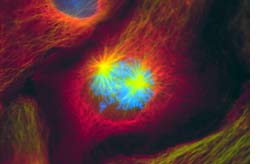 |
 |
|
 |
 |
 |
 |
 |
|
 |
 |
 |
 |

|
| |
 
March 2003, Vol. 12, No.3 | Return to Table of Contents
Advances in Microscopy Propel Scientists' Understanding of Cell Division
MBL is a Gathering Place for the World’s Best and Brightest in Microscopy and Neuroimaging
Over the last 50 years, rapid advances in imaging technology have propelled scientific discovery relating to cell division, specifically the process of mitosis. Mitosis describes the series of steps whereby a cell divides its chromosomes and cytoplasm, producing two genetically identical daughter cells. MBL summer investigators Conly Rieder and Alexey Khodjakov reviewed these advances in microscopy and mitosis research in the April 4 issue of the journal Science.
 Using modern, computer-assisted microscopic imaging, Rieder and Khodjakov study how chromosomes move during cell division, and how progress through cell division is controlled. They investigate the processes involved in mitosis, including how two particular cell structures, kinetochores and centrosomes, function and interact. Because mitosis is such a spectacularly visual event, scientists' more refined understanding of how new cells are Using modern, computer-assisted microscopic imaging, Rieder and Khodjakov study how chromosomes move during cell division, and how progress through cell division is controlled. They investigate the processes involved in mitosis, including how two particular cell structures, kinetochores and centrosomes, function and interact. Because mitosis is such a spectacularly visual event, scientists' more refined understanding of how new cells are
formed in higher animals has historically been linked to breakthroughs in light microscopy technology.
In the Science article, Rieder and Khodjakov note the importance of Shinya Inoué’s research and development efforts in microscopy which were instrumental in defining the cellular events that define mitosis. Inoué, a Distinguished Scientist at the MBL, also pioneered advances in video imaging technology in the early 1980s, revolutionizing the field of light microscopy. Inoué’s use of video cameras in conjunction with powerful light microscopes allowed him and his colleagues to detect, within living cells, the movement of organelles and other cellular components that are invisible to the human eye.
“The simultaneous development of video light microscopy at the MBL in the1980s was driven, in large part, by the scientific questions of the time,” says Rieder. “These questions dealt with how things move in cells, and marine organisms were the best model systems at the time for studying these movements. To this day, the MBL continues to have an international reputation for teaching the best microscopy classes in the world, and also having the best imagers on staff during the summer months.”
Rieder and Khodjakov will both return to the MBL this summer. Rieder will collaborate with colleagues from around the country and the world as part of the “Clam Cluster.” Cluster members use the local surf clam as a model for studying a variety of complex processes within the cell. “Because each summer the MBL brings in outstanding biologists from all over the world, it fosters and expedites unique collaborations,” Rieder says. “Through the years I have found these [collaborations] to be extremely productive.” Khodjakov will be conducting research as the 2003 Nikon Instruments Inc./MBL Research Fellow.
Top scientists in neuroimaging will also work together this summer as part of the MBL’s new “Neuroimaging Cluster.” Investigators in the group, a virtual Who’s Who of leaders in the field, use optical methods to tell them more about mechanisms of synaptic transmission, the basic form of communication between neurons. Using fluorescent dyes and cameras, these imaging studies are aimed at giving scientists a better understanding of epilepsy and Alzheimer’s Disease, as well as psychological diseases such as depression and schizophrenia. According to Dan Johnston, a professor of neuroscience at Baylor College of Medicine and one of the scientists involved, the cluster will provide an environment for scientists to not only collaborate on projects, but, perhaps more importantly, transfer neuroimaging technology within the group. “You’re not going to find a place anywhere else in the world with this concentration of expertise in neuroimaging,” says Johnston. “This is high-tech stuff. The sharing of technical ideas will move this field forward.”
|
 |
|
|
 |
 |
|